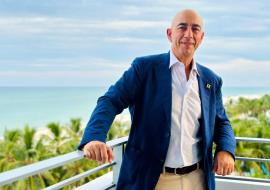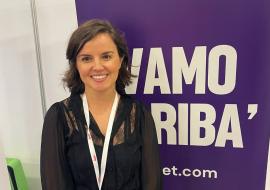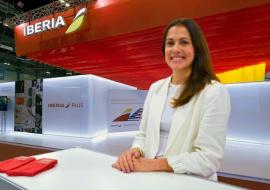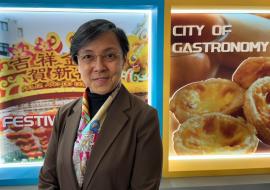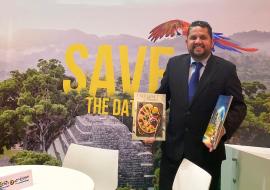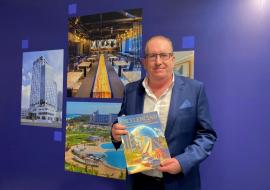Q & A with Rubén Ricardo Sosa, Undersecretary of Tourism, Santiago del Estero (Argentina)
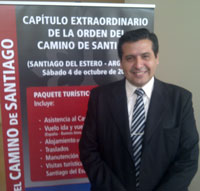
Within the framework of 2014 Termatalia, Rubén Ricardo Sosa, Undersecretary of Tourism from Santiago del Estero in Argentina, shared his ideas on the historic development of this province, which celebrates its anniversaries on the same day as Santiago de Cuba. Furthermore, he analyzed the media hype achieved by Termas de Río Hondo as a result of the world-class events it hosts, and stood up for the gastronomic values that make this Argentinean region a standout.
When was Santiago del Estero founded and what’s the importance of this city within the Republic?
Santiago del Estero is the oldest city of the Argentinean Republic. It was the very first city to be founded, back on July 25, 1553, 461 years ago. Spanish Francisco de Aguirre was its founder. Different colonizing trends came out of Santiago del Estero and brought about the foundation of different cities in the Republic of Argentina.
Both Santiago del Estero and Santiago de Cuba become one year older on the very same date. The city is characterized by its rich historic heritage. This is where the Republic of Argentina was born and Santiago del Estero had the first episcopal see of the Republic at the Basilica cathedral, which is an attractive place for tourists and is visited by thousands of people every year.
Santiago del Estero is known as the cradle of folklore, the national capital of chacarera, which is one of the characteristic rhythms of the city, along with tango. That’s why I say that there is a lot of added value when it comes to showing the history of Santiago del Estero. Its history has plenty of tradition, culture and gastronomy.
Santiago del Estero is famous is terms of regional gastronomy, not only because of its mouth-watering pies, goat’s meat on the stick or, in this particular case, in Termas de Río Hondo, 60 kilometers away from the city, the grilled dorado; but also due to culture shown by its people, that kindness and warmth that characterizes them.
Santiago del Estero has the richest cultural scenery of the Republic of Argentina. We always say that Santiago del Estero remains in the hearts of the people that visit this city.
Nowadays, tourists enjoy, in Termas de Río Hondo, a thermal city that also features great history and complements Santiago del Estero. Perhaps Termas de Río Hondo counts on more attractive elements as a city, with remarkable tourism potential because of the thermal springs; but if we take Santiago del Estero as a historic city, we realize that this is where the Republic of Argentina was born 461 years ago.
Do you think it would be a good idea to organize a meeting with the mayors, secretaries of tourism, of Santiago-named cities from all Latin America?
Actually, what we’re going to do in three days is an initiative promoted by the people that organize Termatalia in Spain and those who live in Santiago del Estero. We’ll have an extraordinary edition of the “Order of Santiago Path”, Santiago de Compostela, as we’re trying to unite all Santiagos from around the world. Today, we’re talking to you, with Santiago de Cuba, and we ratify that spirit of union, confraternity and –why not?- a tourism strategy to foster all Santiagos worldwide. It’s called cooperative action, aimed at having Cuba, Spain, Argentina and Santiago de Quito working side-by-side and boosting these destinations.
Termas de Río Hondo is part of the Santiago del Estero province. Do you believe that hosting such an important event as Termatalia will put this city on the map?
We humbly say that we’re 100 per cent sure that Termatalia is a platform for business, promotion, tourism projects for the people of Termas, specially the private sector. We must keep in mind that Termas de Río Hondo stands among the five Argentinean cities with more hotel rooms, over 12 thousand. We have nearly 200 hotels here, so, this is a great opportunity for people that live in the city, work in the city, have their own business, to make the most of this event.
Termatalia is more than interesting for us, it’s an inflection point for Termas de Río Hondo in terms of the marketplace, since it gathers 27 countries with thermal destinations, over 25 thermal destinations in Argentina; all of them come together here, in Termas de Río Hondo.
The racetrack is another hotspot in the city, where the motorcycling grand prix takes place. When did you inaugurate the circuit?
It’s very interesting, because there is a difference between the relax level reached by tourists in the thermal springs and the adrenaline that moves them because of the speed. The Termas Circuit was inaugurated in 2008, with national category. Nowadays, after six years, we’re witnessing another historic action: we hosted in April one race of the Moto GP championship, after a reform carried out in the racetrack, but that’s not the only thing we’ve done because, when we analyze the year of work from April to April, we’re going to have world-class events: Moto GP, WTCC in august, with grand tourism cars, one of the three categories organized by the International Motoring Federation, we have Termatalia, then we’ll have Dakar on January 15 and it is going to be the first time that Dakar is based in one circuit and the first time that Dakar is visited by tourists with the possibility of having an aerial view of the entire circuit, since there is an aerial bridge.
We are working to have the WTCC back in March and the Moto GP Grand Prix has already been confirmed for April. Five world-class events not only attract people from every corner of Earth, but the most significant element is the global media scope of Moto GP. For instance, this year Moto GP brought about more than 32 thousand pieces of news only in Latin America, over 8 thousand in Arabic, over 6 thousand in Chinese and more than 15 thousand in English. This is the qualitative value of all this matter.
What would the quantitative value be?
Beyond the amount of people that come or have come, the most important thing is the word on the destination out of Argentina. It’s mentioned in Cuba, Ecuador, the Arab world, Abu Dabi, China, Korea is of great worth.
For example, the 150 Dutch people that come to Dakar heard of Termas de Río Hondo by means of the mass media, because the watched Moto GP and saw it, they felt attracted by this destination, the infrastructure and decided to come. This is just an example, a symbol of what Termas de Río Hondo presently means at international level.
In terms of gastronomy and services, what are the virtues of Termas de Río Hondo?
On the gastronomic world, Termas de Río Hondo is one of the most sought-after destinations in the north of Argentina. If you’re here you can’t miss the Santiago pies, grilled dorado, goat’s meat on the stick or Termas de Río Hondo’s barbecued meat. Our gastronomy is most attractive element, the taste, feeling how they cook, how that gastronomy is lived at the city. This is not a new characteristic; it’s decades old. People say that the Inca Empire’s south border was Termas de Río Hondo.
Is the Quechua language spoken here?
Exactly. Santiago del Estero is one of the few provinces in the north of Argentina where there is a lot of people that speak Quechua. That’s why I always say that history is very important. The Inca people used to come down here to enjoy the thermal springs and share their knowledge. Along with its cuisine, Termas de Río Hondo also stands out because of its basketry, the work with plant fibers extracted from the lake or the river. This art was a gift from the Inca Empire, so the natives that lived here guarded the south frontier.
Why does Termas de Río Hondo have so many alfajor factories?
The alfajor factories represent the second economic line of the city. Our citizens are specialists in this sector. There is a peculiar way of making the alfajor, a consequence of the delights made by the people of Santiago as a result of the teachings of their ancestors. The alfajor that is presently being made in Termas de Rio Hondo was created many years ago, the so-called Santiago alfajor. There is a specific way to mix such elements as caramel spread, flour and sugar, so that special taste comes out. The alfajor factories have made a lot of progress and this type of cake is delicious, but there are people that, in their homes, private business, also enrich our cuisine with tortillas, moroncito, chipaco, Santiago alfajor, vegetable-made candies, there is a wide range of products and that’s why we’re so happy to have you here, to show you everything we have.
The candies made at the Catamarta province are the most famous of all. I’ve also heard that here, in Santiago, there are candies made with local fruits.
In Santiago de Estero we have many regional candies, such as the bolanchao, zapallo in syrup, batatas. You have to taste them all to learn what delight feels like. I’m not saying they are the best of the world, but they are quite peculiar. There is this characteristic taste.








